Editorial: Old Tools – New Tools
Stroma and Skye
Misadventure and Redemption on the Otryt Trail
Meeqi’s Gift
A Boys' Trip on Dovrefjell
Tumivut: Traces of our Footsteps
New Site/Old Site
Piksuk Media's Nunavut Quest Project Progress Report
Media Review: Nunavut Quest: Race Across Baffin
IMHO: Let's Talk
Navigating This Site
Index of articles by subject
Index of back issues by volume number
Search The Fan Hitch
Articles to download and print
Ordering Ken MacRury's Thesis
Our comprehensive list of resources
Defining the Inuit Dog
Talk to The Fan Hitch
The Fan Hitch home page
ISDI home page
Editor's/Publisher's Statement
Editor: Sue Hamilton
Webmaster: Mark Hamilton
The Fan Hitch welcomes your letters, stories, comments and suggestions. The editorial staff reserves the right to edit submissions used for publication.
Contents of The Fan Hitch are protected by international copyright laws. No photo, drawing or text may be reproduced in any form without written consent. Webmasters please note: written consent is necessary before linking this site to yours! Please forward requests to Sue Hamilton, 55 Town Line Rd., Harwinton, Connecticut 06791, USA or mail@thefanhitch.org.
This site is dedicated to the Inuit Dog as well as related Inuit culture and traditions. It is also home to The Fan Hitch, Journal of the Inuit Sled Dog.
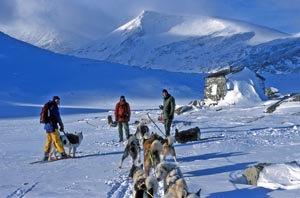
Dag, Jon and Harald taking a short break outside
the
stone hut Loennechenbua,
hunting
cabin.
Photo: Arnar Lyche
A Boys' Trip on Dovrefjell
by Arnar
Lyche
Molde, Norway
Once upon a
time there were 20 Greenland Dogs, six "old boys" and one
real boy who
ventured into the mountains. In modern terms this
four-day/38 km (24 mi) trip took place between January and
February 2002. The participants, traveling to the starting
point from as far away as 5.5 hours, were Jon Bjorshol
with his four dogs, Harald Klaebo and Dag Vangby with Harald's two dogs, Terje Thomassen and
his friend Odd Gabrielli with
seven dogs, while my son Lars and I also had a team of
seven in front of our sled.
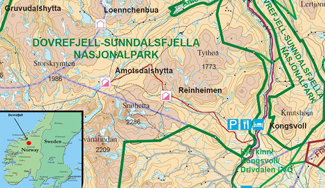
Park map courtesy of Norwegian Directorate for
Nature
Management. Inset courtesy of
Scantours.
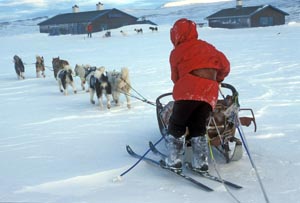
Lars and the team arriving at Amotsdalshytta.
Photo:
Arnar Lyche
In
temperatures well below -20°C/-4°F, it is nice to use the
safety hut at Reinheim for lunch. The main cabin is closed
from November 15th to February 15th,
but the safety hut is great for both overnight trips and
day stops.
From Reinheim
we continued towards Amotsdalshytta. There were two routes
to choose between, one straight ahead through
Leirpullskaret, a steep and narrow mountain pass, the
other, slightly longer, to the right through Vegskaret, a
slightly less steep and more open pass. After very strong
recommendations from Jon, who started a few hours ahead of
us, we chose the latter alternative. The distance from
Reinheim to Amotsdalshytta is about 11 km (6.8 mi).
Climbing the
pass was hard on the dogs. At the top, my team of seven
followed the tracks Jon and his team made. When their
tracks turned sharply to the left, my lead dogs wanted to
go straight ahead. At the last moment they followed my
commands and we instantly found ourselves in a steep
downhill. Before we knew what was happening, we were
through the pass. When I turned around and looked back, I
saw Harald on his stomach, with his two dogs and pulka
ahead of him, lying over the crest of the hill. At the
same time I also saw that had my dogs gone straight ahead,
we would have gone straight off a large snow cornice.
After a short struggle Harald got his dogs and pulka
safely down to the rest of us. We all agreed that the
brake on his pulka was not good enough.
The rest of
the way to the cabin traversed through open terrain with a
clear view of the Amotsdalen valley. We were now a long
way from motorized transport or infrastructure such as
power lines, reservoirs etc. It was a wonderful feeling,
skiing behind the Nansen sled with seven eager dogs in
front in this breathtakingly beautiful scenery. We reached
the cabin just as it was getting dark. Jon was standing in
the doorway to greet us. He had been here a few hours
already.
It was easy
to feel sorry for the dogs. After a day of hard work, they
were simply staked out in the cold wind. At that moment it
was about -20°C/-4°F and they had nothing to protect them
from the icy wind. Their food was simply a few handsful of
pellets dropped on the ground. We on the other hand
entered a warm cabin, enjoyed a good meal before we went
to sleep in a warm sleeping bag on a soft bed. Maybe we
would be punished by being reincarnated as Greenland Dogs
in our next life.
After a
comfortable night, listening to the wind howling around
the corners of the cabin, we were rewarded with a clear
and sunny day. There was still a cold wind, but as long as
we didn't stand still too long it was not a problem.
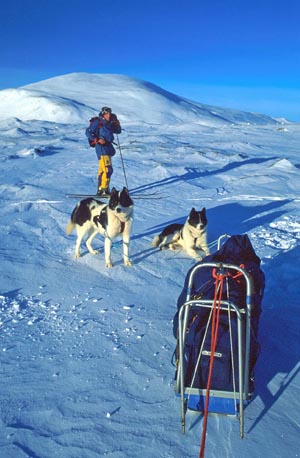
Dag taking a break with the dogs
Bojar and
Angelak.
Photo:
Harald Klaebo
Jon was
familiar with the area and lead us on a guided roundtrip
along the valley. The month of January had been very windy
and in places the snow was packed as hard as concrete, so
dogsledding in the mountains was pure joy. We had the
mountains Snohetta and Svanatindane to the south while
Storskrymten showed itself from its best view when we
turned our heads in the opposite direction.
We didn't see
any wild reindeer, but their scats in the area were proof
of their presence. This mountain area is also an important
habitat for wolverine and arctic fox. We wanted to stop
for a lunch break by an old boat shed, but it was too
cold. We preferred eating back at the cabin instead.
Terje and Odd
arrived later in the day. From Reinheim they had chosen
the shortest route, going over the steeper pass,
Leirpullskaret. In their sled they brought along four, two
month-old puppies. When they finally arrived at the cabin
they told of a challenging trip through the pass. Parts of
the way there were just rocks and ice, with no snow to
steer the sled. Terje was very eager to check if the
puppies had made it alright. As he set his snow hook four
eager and curious puppies crawled out of the sled. It
obviously would take more than a bumpy ride for them to
lose their spirit!
This turned
into a very pleasant evening with reindeer on the menu and
puppies peeing on the floor. On a boys' trip like this,
after a few beers and, it being Saturday night, it would
have been natural for the discussions to revolve around
ladies. But this theme was ousted in favour of dogs,
breeding, feeding, the consistency of faeces and other
related subjects. Whether this should be interpreted as a
good or bad sign, I'm probably not the right person to
comment.
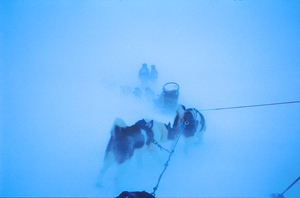
Trying to navigate during a blizzard and whiteout conditions.
Photo: Harald Klaebo
Sunday
morning everyone left and started the return trip. We
failed to notice the weather changing while we were
clearing out the cabin, packing the sleds and harnessing
the dogs. All of a sudden the wind picked up and the
blowing snow in the air reduced visibility to a minimum.
We kept going for three hours before admitting to
ourselves we couldn't continue further. Fortunately we had
plenty of safety gear in our sleds. There were plenty of
hands to pitch two tents, secure the guy lines and shelter
them from the wind using every trick in the book.
It was two
o'clock in the afternoon when we stopped, and since the
weather showed no signs of improving as the afternoon bore
on, we decided to spend the night. The dogs were left in
harness in front of the sleds until we could continue.
Through the night the wind only grew stronger and we had
more than enough of the outdoors whenever we rushed out to
pee. One wouldn't last long unprotected in such
conditions. Being inside a tent, sheltered from the
weather, with warm sleeping bags and a stove to give heat,
life was still relatively comfortable.
The contrast
to the dogs waiting out the storm outside was big. It did
however demonstrate what conditions they are adapted to
handle without difficulty. The four puppies that stayed
outside with their mother especially impressed us. Through
the long history of the Greenland Dog many puppies have
had to handle extreme weather conditions and the breed has
adapted to this.
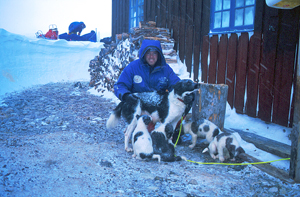
Terje with a proud mother and a litter of eager
puppies.
Photo:
Harald Klaebo
Hearing the
wind pounding the nylon walls, I laid in the tent during
the early morning hours thinking we might be stuck here
for days. The situation was worst for those waiting at
home who expected us back last night. I felt a great
responsibility for Lars, my 10 year-old son, whom I
brought along. But he was taking things with great ease
and I heard him sleeping soundly next to me.
In a matter
of minutes the wind suddenly dropped and we quickly got
out to check the weather. Visibility was now good enough
for us to keep going. We were terrified the wind would
start blowing again before we could get through Vegskaret.
We didn't take the time to eat anything. We just broke
camp and got going. We made it through the pass without
any problems and stopped at Reinheim for breakfast.
The last
stretch from Reinheim to Gronbakken, where we had parked
our cars, went at a steady pace almost without stopping.
We felt the need to hurry in order to inform everyone at
home that all was well.
I wanted to
tell about this trip because looking back it felt like a
very good experience. We were really put to the test and
at the same time kept our spirits high. The dogs had the
opportunity to show what they are made of, both from
working in front of the sled, but also how easily they
handle the mountains and harsh weather.
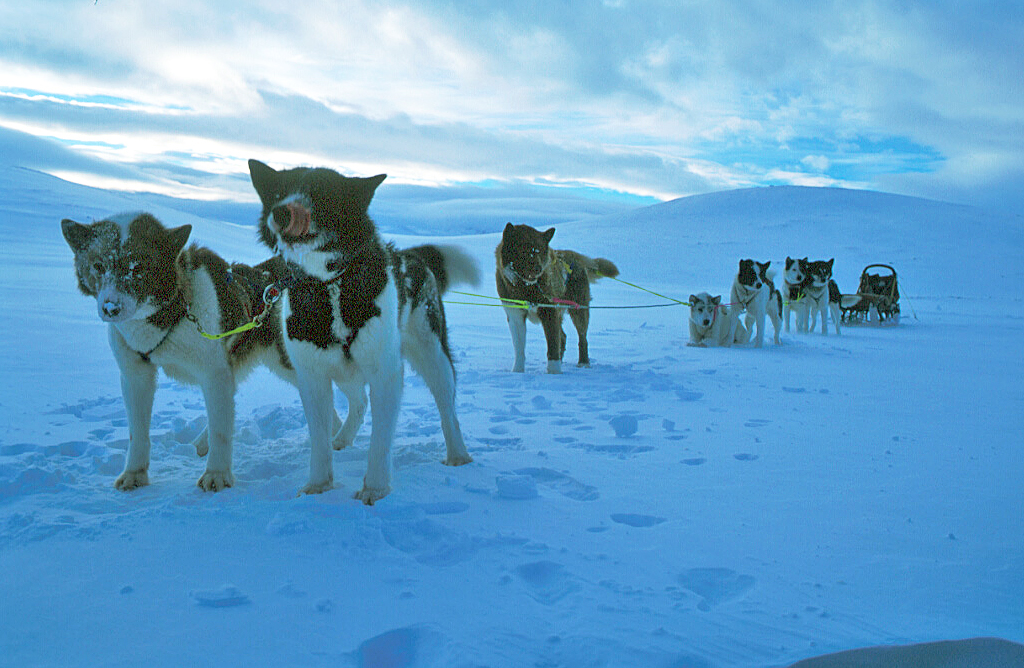
Arnar's team ready to go.
Photo: Harald Klaebo
Arnar Lyche is
an agricultural consultant and enthusiastic
Greenland Dog owner living outside Molde,
Norway. He is a devoted family man, eternal
optimist and an everlasting source of energy.
Arnar has three children, now aged 16, 18 and
20, whom he has brought along on wilderness
trips since they were very young. Everyone who
has tried knows the challenge of being on top
of a situation involving 6-10 Greenland Dogs,
which at times can be enough for anybody. Add
some rough weather, three children and a
smiling and happy father to the mix, and you
just about have Arnar in a nutshell.
The Fan Hitch
thanks Gisle Uren for translating this story
and for collecting additional details,
images, captions and maps.